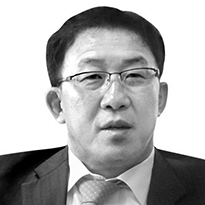The shadow of industry polarization
Published: 15 Oct. 2024, 20:07

Ahn Dong-hyun
The author is a professor of economics at Seoul National University.
During the first half of last year, an economic ministry held a meeting with experts at home and abroad on the future of economic outlook and policies. At the time, the growth rate of the first quarter was 1.1 percent, so the question was when the economy would rebound.
As I remained silent throughout the meeting, the hosting minister asked about my opinion. I told him that there was a problem with the participants invited to the discussion. I said that we would have been better off if he had invited semiconductor industry experts rather than economists.
At that time, the semiconductor industry was struggling to get out of the doldrums after an unexpected boom in global demand for IT products after the pandemic. Subsequently, the trade balance showed no signs of rebounding after recording deficits since early 2022.
My answer was based on the fact that the semiconductor industry held the key to a full-fledged economic recovery. In fact, the semiconductor industry revived from last October — the growth rate in the fourth quarter of 2023 broke out of the 1 percent range and grew to 2.1 percent.
The importance of the semiconductor industry to Korea’s exports and economic growth is absolute. The share of chips in total exports exceeded 20 percent for the first time in the fourth quarter in 2017. It has been recording percentages in the upper tens and lower twenties until recently. Adding in the automotive and component industries, the share is over 30 percent.
The petrochemical sector, which has also been driving exports and growth, is suffering from oversupply due to China’s aggressive exports. While K-food and K-beauty products have emerged among the five core export industries, their shares are relatively insignificant.
Therefore, the semiconductor industry has come to decide the Korean business cycle. The situation of the semiconductor industry has even led to worries about tax revenues. As of March, corporate taxes, which account for 20 percent of total tax revenues, were down by 26 percent compared to that of the same period last year, when Samsung Electronics and SK hynix were unable to pay any corporate taxes due to their poor performances.
In its recent report, Morgan Stanley warned of a “semiconductor winter.” In response, stock prices of Samsung Electronics and SK hynix plummeted. While the report may have been exaggerated, it is still worrisome, especially with Samsung’s poor performance during the third quarter of this year.
The industries driving Korea’s economic growth have become increasingly polarized, with the entire economy linked to the performance of a few key categories. This could be an inevitable problem of the transition to a knowledge- and -information-based economy, but for Korea, the phenomenon is more intense as it took place at the same time as the reorganization of the conglomerate system. Most conglomerates are currently transitioning to a third-generation management system. Industries are beeing polarized fast as the major business groups are declining — with the exception of giants like Samsung, Hyundai Motor, SK, LG and Hanwha.
We have long criticized economic polarization. But we have mainly focused on two parts of economic polarization — income polarization and polarization between large and small companies — and we have paid little attention to industry polarization, which determines the relative distribution of large and small companies and also leads to wage disparities between industries. Unless the problem is solved, no amount of artificial adjustment through taxation or other support measures can resolve the polarization of wages and businesses.
The most effective response is to steadily create new growth engines. This can only be done if there is a constant supply of new industries to replace the declining ones. The industries which are feeding our economy are the product of two bold decisions by the late President Park Chung Hee in the 1960s to develop the heavy chemical industry and by the late Samsung Chairman Lee Kun-hee in the 1990s to invest in semiconductors.
The failure to find industries to replace these two has resulted in the industry polarization, which resulted in income and business polarization. This is why distributional equity is deteriorating while potential growth is stagnating. We must not waste the golden age of our economy — the most prosperous period since the foundation of the country. If we don’t want future generations to remember our generation as a dark chapter in history, it’s time to prepare a new growth engine for them.
Translation by the Korea JoongAng Daily staff.










with the Korea JoongAng Daily
To write comments, please log in to one of the accounts.
Standards Board Policy (0/250자)